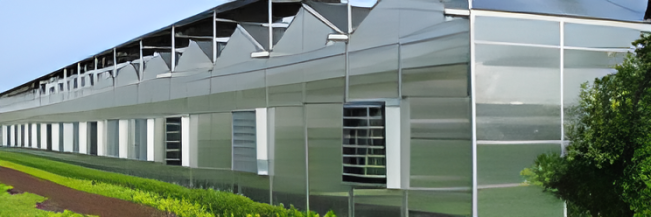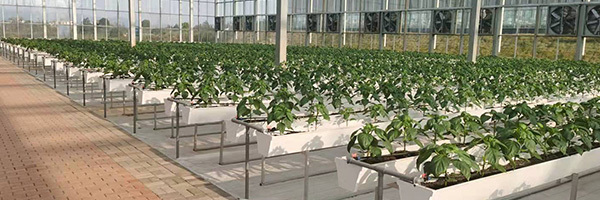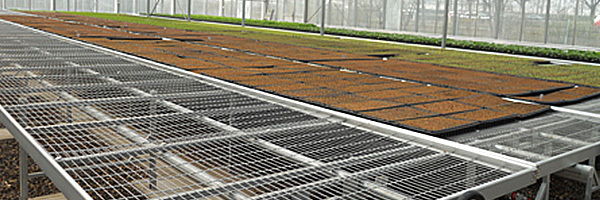-
-
Company Profile
-

Greenhouse Structures

-
Polycarbonate sheet greenhouse
-
Glass greenhouses
-
Multi-Span film greenhouse
-
Solar greenhouse
-
Sightseeing greenhouse
-
Double-film frame solar greenhouses
-
Glass and polycarbonate sheet greenhouses
-
Glass greenhouses structures suitable for planting
-
Glass Greenhouse for Scientific Research
View More -
-

-

Creating a Controlled Environment: An In-Depth Exploration of Glass and Polycarbonate Greenhouses
Release time:
2025-05-07
Creating a Controlled Environment: An In-Depth Exploration of Glass and Polycarbonate Greenhouses In the world of agriculture, the quest for maximizing yield and ensuring healthy plant growth has led to the development of controlled environments. Greenhouses serve as vital tools in this endeavor, with glass and polycarbonate structures emerging as leading options. Understanding the nuances between

Creating a Controlled Environment: An In-Depth Exploration of Glass and Polycarbonate Greenhouses
In the world of agriculture, the quest for maximizing yield and ensuring healthy plant growth has led to the development of controlled environments. Greenhouses serve as vital tools in this endeavor, with glass and polycarbonate structures emerging as leading options. Understanding the nuances between these two materials is crucial for anyone looking to optimize their growing conditions. This article will provide a thorough analysis of glass and polycarbonate greenhouses, discussing their features, benefits, and how to choose the right one for your agricultural needs.
Table of Contents
- Understanding Greenhouses: The Basics
- Why Controlled Environments Matter in Agriculture
- Glass Greenhouses: Pros and Cons
- Polycarbonate Greenhouses: Pros and Cons
- Comparing Glass and Polycarbonate: Which is Right for You?
- Installation and Maintenance of Greenhouses
- Environmental Impacts and Sustainability
- Frequently Asked Questions
Understanding Greenhouses: The Basics
Greenhouses are structures designed to create a controlled environment that promotes plant growth by regulating temperature, humidity, and light. By harnessing solar energy, they provide a stable climate that can significantly increase the productivity of crops. Greenhouses come in various shapes and sizes, but the materials used for their construction play a critical role in their effectiveness.
What is a Greenhouse?
A greenhouse is essentially a building made of transparent materials that allow sunlight to enter while trapping heat. This creates a microclimate that supports plant growth. The two most common materials used for greenhouse construction are glass and polycarbonate, each offering distinct advantages and disadvantages.
Why Controlled Environments Matter in Agriculture
In the face of climate change and varying weather patterns, controlled environments are essential for sustainable agriculture. They provide a means to extend growing seasons, protect plants from pests, and ensure consistent growth conditions. Farmers and gardeners increasingly turn to greenhouses to maximize their yields and reduce risks associated with unpredictable weather.
The Importance of Temperature Regulation
Temperature control is crucial for the successful cultivation of many crops. Greenhouses help maintain optimal temperatures, allowing plants to thrive regardless of external weather conditions. This not only aids in plant health but also enhances the quality and quantity of produce.
Glass Greenhouses: Pros and Cons
Glass greenhouses have been a staple in horticulture for centuries, offering a classic look and excellent durability. However, they come with both advantages and disadvantages.
Advantages of Glass Greenhouses
- Light Transmission: Glass allows for exceptional light penetration, which is vital for photosynthesis.
- Durability: Glass is highly durable and can last for many years, making it a long-term investment.
- Aesthetic Appeal: The clear, classic look of glass greenhouses often enhances the visual appeal of gardens and farms.
- Easy to Clean: Smooth glass surfaces can be easily cleaned, ensuring optimal light transmission.
Disadvantages of Glass Greenhouses
- Heat Loss: Glass can lead to significant heat loss during colder months, requiring additional heating solutions.
- Weight: Glass is heavy, which can complicate the construction and support structure.
- Cost: Typically, glass greenhouses are more expensive to install than their polycarbonate counterparts.
Polycarbonate Greenhouses: Pros and Cons
Polycarbonate greenhouses have gained popularity due to their versatility and cost-effectiveness. These structures are made from a type of plastic that offers a different set of benefits and challenges.
Advantages of Polycarbonate Greenhouses
- Insulation: Polycarbonate panels provide excellent insulation, reducing heat loss and keeping temperatures stable.
- Lightweight: Compared to glass, polycarbonate is much lighter, making it easier to handle and install.
- Impact Resistance: Polycarbonate is highly resistant to impact, making it less likely to break during storms or extreme weather.
- Cost-Effective: Generally, polycarbonate greenhouses are more affordable than glass structures, both in purchase and installation.
Disadvantages of Polycarbonate Greenhouses
- Light Diffusion: While polycarbonate allows light to penetrate, it may diffuse it more than glass, which can affect photosynthesis.
- Less Aesthetic Appeal: Some consider the look of polycarbonate greenhouses less visually appealing than glass options.
- Long-Term Durability: Although durable, polycarbonate may yellow and degrade over time, affecting performance.
Comparing Glass and Polycarbonate: Which is Right for You?
Deciding between glass and polycarbonate greenhouses largely depends on individual needs, preferences, budget, and the specific crops being cultivated. Here are several factors to consider:
1. Budget Considerations
If budget is a primary concern, polycarbonate may be the better choice due to its lower initial cost and reduced maintenance expenses. Glass greenhouses, while more durable, often require a larger investment upfront.
2. Climate Conditions
In regions with extreme temperature variations, polycarbonate greenhouses may offer better insulation and heat retention. In contrast, glass greenhouses excel in moderate climates where abundant sunlight is available.
3. Crop Types
The choice of greenhouse material should also be influenced by the types of plants being grown. Delicate crops may benefit from the gentle light diffusion of polycarbonate, while high-light plants might thrive better in glass structures.
4. Aesthetic Preferences
For those prioritizing aesthetics, glass greenhouses provide a classic and elegant appearance, making them suitable for ornamental gardens or public displays. Polycarbonate options, while practical, may not have the same visual appeal.
Installation and Maintenance of Greenhouses
The installation process for both glass and polycarbonate greenhouses requires careful planning. Here’s a breakdown of what to expect:
Installation Process
Regardless of the material chosen, proper site selection, foundation preparation, and structural assembly are vital. It's essential to follow specific guidelines for each type of greenhouse to ensure stability and longevity.
Maintenance Tips
Maintaining your greenhouse is critical for its effectiveness. Here are some tips:
- Regular Cleaning: Clean the surfaces regularly to maximize light penetration and prevent diseases.
- Check for Damage: Regularly inspect the structure for cracks or leaks, especially after severe weather.
- Temperature Monitoring: Invest in temperature monitoring tools to ensure optimal growing conditions year-round.
Environmental Impacts and Sustainability
As the agricultural sector increasingly focuses on sustainability, the environmental impacts of greenhouse materials must be considered. Glass is recyclable and contributes less plastic waste, while polycarbonate, although durable, can take longer to decompose.
Energy Efficiency
The energy efficiency of a greenhouse can significantly impact long-term operating costs and environmental footprints. Polycarbonate greenhouses often require less energy for heating and cooling, making them more environmentally friendly in certain climates.
Frequently Asked Questions
1. How long do glass and polycarbonate greenhouses last?
Glass greenhouses can last 20 years or more with proper maintenance, while polycarbonate structures typically last around 10-15 years, depending on environmental factors.
2. Can I heat a greenhouse effectively with either material?
Yes, both glass and polycarbonate greenhouses can be heated effectively. However, polycarbonate generally retains heat better, which may reduce heating costs.
3. Are there any pests that can affect greenhouses?
Yes, pests such as aphids, spider mites, and whiteflies can invade greenhouses. Regular monitoring and integrated pest management strategies are essential to mitigate these risks.
4. What are the best crops for greenhouse cultivation?
Popular greenhouse crops include tomatoes, cucumbers, peppers, and herbs, but the choice largely depends on the specific greenhouse conditions and local climate.
5. Do greenhouses require ventilation?
Absolutely! Proper ventilation is crucial to prevent overheating and maintain optimal humidity levels. Both glass and polycarbonate greenhouses should incorporate ventilation solutions.
Conclusion
Choosing the right greenhouse is a significant decision that can impact crop yield and quality. Both glass and polycarbonate greenhouses offer unique advantages tailored to different agricultural needs. By understanding the benefits and drawbacks of each type, along with considerations for climate, budget, and aesthetics, growers can make informed decisions that enhance their agricultural practices. Embracing controlled environments through the right greenhouse not only leads to better production but also contributes to sustainable farming practices in an ever-evolving agricultural landscape.
Keyword:
Related News
The Allure of Glass Greenhouses: A Perfect Blend of Nature and Architecture
Glass greenhouses have become increasingly popular among gardening enthusiasts and architects alike, merging the beauty of nature with innovative design. These structures are primarily designed to allow maximum sunlight exposure while providing a controlled environment for plants to thrive. The transparency of glass not only creates an aesthetically pleasing space but also plays a crucial role in
2025-05-12
Creating a Controlled Environment: An In-Depth Exploration of Glass and Polycarbonate Greenhouses
Creating a Controlled Environment: An In-Depth Exploration of Glass and Polycarbonate Greenhouses In the world of agriculture, the quest for maximizing yield and ensuring healthy plant growth has led to the development of controlled environments. Greenhouses serve as vital tools in this endeavor, with glass and polycarbonate structures emerging as leading options. Understanding the nuances between
2025-05-07
Optimal Glass Greenhouse Structures for Effective Plant Cultivation
When considering glass greenhouse structures suitable for planting, several critical factors come into play, particularly in the fields of architectural design and material selection. Glass greenhouses are increasingly favored due to their efficiency in harnessing natural sunlight, which is a crucial component for plant growth. The ability to control environmental conditions within these structure
2025-05-02
Creating a Sustainable Garden with Glass Greenhouses: A Comprehensive Guide
Creating a Sustainable Garden with Glass Greenhouses Table of Contents Introduction to Sustainable Gardening and Glass Greenhouses Benefits of Using Glass Greenhouses for Sustainable Gardening Different Types of Glass Greenhouses Designing Your Sustainable Glass Greenhouse Best Plants for Glass Greenhouses Maintaining Your Glass Greenhouse for Long-Term Sustainability
2025-04-29
Innovative Glass Greenhouses: A Gateway to Scientific Research
Glass greenhouses for scientific research have become an essential tool for researchers and scientists looking to conduct controlled experiments in a variety of fields, including botany, horticulture, and environmental science. These structures are designed to provide an optimal environment for plant growth and experimentation, enabling researchers to manipulate variables such as temperature, humi
2025-04-26
Contact Information
Address: Hebei University of Technology Science and Technology Park, High tech Zone, Cangzhou City, Hebei Province
International Trade Office: Huashang Building, Yunhe District, Cangzhou City (500 meters east of Cangzhou West High speed Railway Station)
Tel:+86 15301369860

Online message
-







